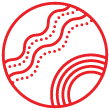Invasive species and pathogens pressure on Fraser Island (K'gari)
Key Finding
The introduction of invasive plants, animals and pathogens to the Fraser Island (K’gari) World Heritage Area is having a negative impact on some World Heritage values.
More than 200 invasive species are present on K’gari. These include:
- weeds such as bitou bush, Easter cassia, Abrus, Singapore daisy and asparagus fern
- pests such as the pandanus leafhopper, Jamella australiae
- feral animals including cane toads, cats, horses and fire ants
- pathogens such as myrtle rust (Myrtaceae plant spp) and chytridiomycosis (acid frogs).
The pest and weed distribution is limited in extent, and the severity of the threat is variable, with only minor impacts on the attributes of the World Heritage Outstanding Universal Value. Management programs have actively targeted some of the key high-risk pest species.
Myrtle rust has been found in a range of different ecosystems including rainforest, coastal heath, and paper bark wetlands.
- Myrtle rust is caused by the introduced exotic airborne rust fungus Austropuccinia psidii.
- Its impact is being researched, at both species and plant community levels, to assist in the development of species conservation and management plans.
- Myrtle rust has not yet been detected on Satinay (Syncarpia hillii), which forms an important attribute of the island’s Outstanding Universal Value. Greenhouse trials have demonstrated susceptibility of seedlings to myrtle rust.
- Biosecurity capacity is being enhanced.
- The current and future risk to World Heritage values is, as yet, unknown.
- Targeted monitoring will help identify impact on the island and establish study sites to determine impacts, if any, long-term.
This threat is currently considered ‘low’.
More information:






